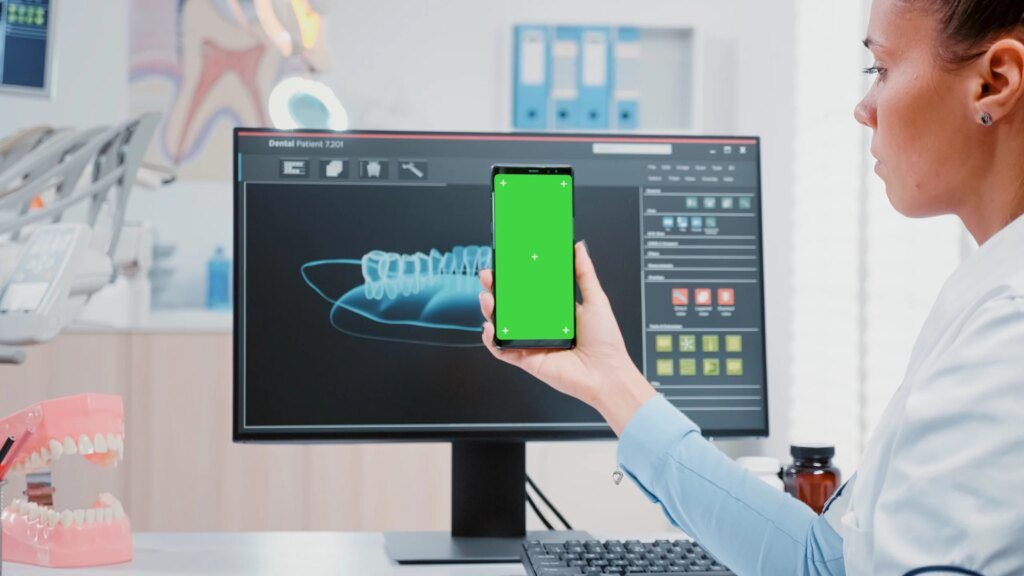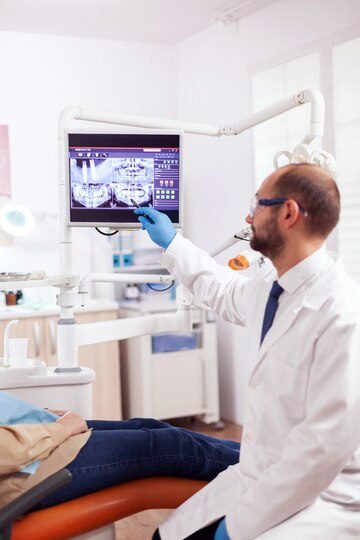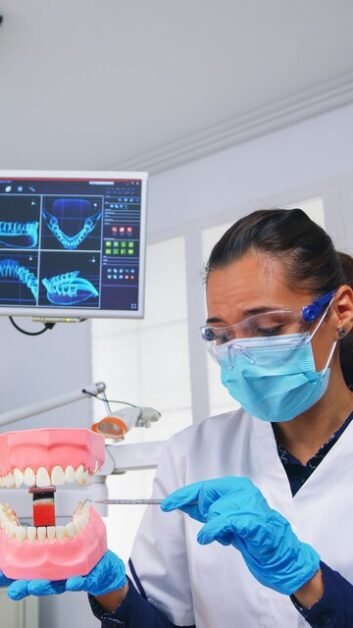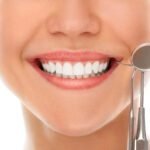Table of Contents
Digital Impressions: The Future of Dentistry & Orthodontics
The world of dentistry and orthodontics is constantly evolving, and one significant advancement that is shaping the future of these fields is the emergence of digital impressions. Traditional dental impressions, which require patients to bite into a tray filled with putty-like material, can be uncomfortable and time-consuming. However, digital impressions offer a more efficient and patient-friendly alternative.
Digital impressions involve using advanced imaging technology to create a highly accurate 3D model of a patient’s teeth and gums. This process eliminates the need for messy impression materials and allows for a more precise representation of the patient’s oral anatomy. Not only does this enhance the accuracy of treatment planning and fabrication of dental restorations, but it also reduces chair time for patients, making their experience more comfortable and convenient.
Moreover, digital impressions have the potential to streamline the workflow in dental practices and laboratories. The digital files can be easily and quickly transmitted between the dentist and the lab, reducing the risk of errors and ensuring a smoother collaboration. Additionally, the use of digital technology allows for more efficient storage and retrieval of patient records, thereby improving overall practice management.
With these numerous advantages, it is clear that digital impressions are poised to revolutionize the field of dentistry and orthodontics. As technology continues to advance, we can expect further improvements in accuracy, efficiency, and patient comfort. The future looks bright as digital impressions become an integral part of the treatment process, ultimately transforming the way we approach dental care and orthodontic treatments.

Advantages of Digital Impressions
Digital impressions have revolutionized the field of dentistry by offering numerous advantages over traditional impressions. One major advantage is the improved accuracy and precision achieved with digital impressions. The use of advanced imaging technology allows for detailed and highly accurate scans of the patient’s teeth and gums, resulting in more precise treatment planning and better-fitting restorations. In fact, studies have shown that digital impressions have a significantly higher accuracy rate compared to traditional impressions, reducing the need for remakes and adjustments.
Another advantage of digital impressions is the enhanced patient comfort they provide. Traditional impressions often involve the use of bulky trays filled with impression material that can cause gagging and discomfort for patients. In contrast, digital impressions are performed using a small handheld wand that captures the digital images of the teeth and gums, eliminating the need for uncomfortable trays. This not only improves the overall patient experience but also increases patient satisfaction and reduces the likelihood of treatment refusal or non-compliance.
Additionally, the speed and efficiency of digital impressions greatly reduce chair time, allowing for a more efficient workflow and increased productivity for dental practices. These time savings can be particularly beneficial for patients who require multiple impressions or those with busy schedules. Overall, the advantages of digital impressions make them an invaluable tool in modern dentistry, offering improved accuracy, enhanced patient comfort, and streamlined workflows for both dentists and patients alike.
| Advantages of Digital Impressions | Explanation |
|---|---|
| Accuracy | Digital impressions offer high precision and accuracy, capturing detailed tooth anatomy more effectively than traditional methods. |
| Comfort | Patients experience less discomfort during digital impressions compared to traditional methods, as they involve minimal physical contact and no messy impression materials. |
| Efficiency | Digital impressions can be completed more quickly than traditional impressions, reducing chair time and overall treatment duration. |
| Improved Workflow | Digital impressions streamline the workflow for dental professionals, allowing for easier communication, storage, and retrieval of patient data. |
| Reduced Errors | The digital process minimizes the risk of errors often associated with traditional impression materials, such as distortion or air bubbles. |
| Patient Engagement | Patients can visualize their dental anatomy in 3D, fostering better understanding and engagement in their treatment plans. |
| Environmentally Friendly | Digital impressions eliminate the need for disposable materials, reducing waste and promoting eco-friendliness in dental practices. |
| Remote Collaboration | Digital impressions facilitate remote collaboration between dental professionals, enabling consultations and treatment planning from different locations. |
| Archiving and Replication | Digital impressions can be stored digitally for future reference and replication, eliminating the need for physical storage space and the risk of deterioration over time. |
| Integration with CAD/CAM | Digital impressions seamlessly integrate with CAD/CAM technologies for the fabrication of restorations, crowns, bridges, and other dental prosthetics. |
The Evolution of Dental Impressions
Over the years, dental impressions have undergone a significant evolution, thanks to advancements in technology. Traditionally, dental impressions involved the use of messy, uncomfortable materials like alginate or polyvinyl siloxane to create molds of a patient’s teeth and gums. These impressions were then used by dentists and orthodontists to create custom-fitted dental prosthetics or orthodontic appliances.
However, with the introduction of digital technology, the process of taking dental impressions has been revolutionized. Digital impressions, also known as intraoral scanning, utilize state-of-the-art equipment that captures 3D images of a patient’s mouth. This technology eliminates the need for uncomfortable material impressions, making it a more comfortable and convenient experience for patients.
The use of digital impressions also brings numerous benefits to both dental professionals and patients. These digital scans are highly accurate, allowing for precise measurements and better-fitting dental prosthetics or orthodontic appliances. They also save valuable chair time, as the scanning process is quicker than traditional impression taking. Overall, the evolution of dental impressions has brought about a new era in dentistry, offering improved accuracy, enhanced patient comfort, and streamlined workflows.
The Role of Digital Technology in Dentistry
Digital technology has revolutionized the field of dentistry, playing a crucial role in improving patient care and treatment outcomes. The use of digital technology in dentistry has brought about significant advancements in various aspects of dental practice, including diagnosis, treatment planning, and the fabrication of dental prosthetics.
One of the key roles of digital technology in dentistry is in the area of digital imaging. Digital imaging techniques, such as cone beam computed tomography (CBCT) and intraoral scanners, enable dentists to capture highly detailed and accurate images of the oral cavity. This not only aids in the early detection and diagnosis of dental conditions, but also provides a precise and comprehensive view of the patient’s dental anatomy, allowing for more effective treatment planning. Moreover, digital imaging eliminates the need for traditional film-based X-rays, reducing the patient’s exposure to radiation and enabling easier storage and retrieval of images.
In addition to digital imaging, digital technology has also transformed the process of dental prosthetics fabrication. With the advent of computer-aided design and computer-aided manufacturing (CAD/CAM) systems, dental labs can now produce highly accurate and customized dental restorations, such as crowns, bridges, and implants, in a fraction of the time compared to traditional methods. This not only improves the efficiency of the dental lab workflow but also enhances the overall patient experience by reducing chair time and the need for cumbersome physical impressions. Furthermore, CAD/CAM systems allow for greater precision and quality control, resulting in dental prosthetics that fit better and provide superior esthetics and functionality.
The role of digital technology in dentistry is undeniably transformative. It empowers dentists with advanced capabilities, enhances patient care, and improves treatment outcomes. As the field of dentistry continues to evolve, embracing digital technology will be imperative for staying at the forefront of dental practice and delivering optimal oral healthcare to patients.

Improving Accuracy with Digital Impressions
Digital impressions have revolutionized the accuracy of dental and orthodontic treatments. By eliminating the need for messy traditional impressions, this advanced technology enables dentists to capture precise measurements of patients’ teeth and gums, resulting in more accurate restorations and treatment plans.
With traditional impressions, there is a margin of error due to factors like material distortion and patient discomfort, which can affect the accuracy of the final result. However, digital impressions provide a high level of precision by creating a virtual 3D model of the patient’s mouth. This allows dentists to capture every detail with exceptional accuracy, resulting in restorations that fit perfectly and align with the patient’s natural dentition.
In addition to improved accuracy, digital impressions also offer other advantages such as increased patient comfort and reduced chair time. Patients no longer have to endure the discomfort of having gooey impression material placed in their mouths for an extended period. Instead, a digital scanner is used to quickly and comfortably capture the necessary measurements. This not only enhances the patient experience but also allows dentists to complete procedures more efficiently, reducing overall chair time and increasing productivity in the dental office.
Enhancing Patient Comfort with Digital Impressions
Digital impressions have revolutionized the dental industry by significantly enhancing patient comfort during the impression-taking process. Traditional impressions often involved uncomfortable trays filled with putty-like material, causing gag reflexes and discomfort for many patients. However, digital impressions eliminate the need for these physical impressions altogether. Instead, a small handheld device is used to capture detailed 3D images of the patient’s teeth and gums. This process is not only more comfortable for patients but also offers greater accuracy and efficiency in capturing dental impressions.
By transitioning to digital impressions, dental professionals can cater to patients who may have experienced anxiety or discomfort during traditional impression procedures. The handheld device used in digital impressions is non-invasive and allows for quick and precise imaging of the oral cavity. This eliminates the need for patients to endure lengthy and uncomfortable impressions, leading to a more positive overall dental experience. Additionally, digital impressions offer the added advantage of immediate feedback, allowing the dentist to assess the quality of the impression on the spot and make any necessary corrections or adjustments. Overall, the implementation of digital impressions has transformed the patient experience, making dental visits more comfortable and stress-free.
Reducing Chair Time with Digital Impressions
Digital impressions have revolutionized the dental industry, providing significant benefits for both dentists and patients. One of the key advantages of digital impressions is their ability to reduce chair time during dental procedures. Traditional impressions require the use of impression materials that need time to set, which can prolong the appointment and cause discomfort for patients. With digital impressions, dentists can capture highly accurate 3D images of the patient’s teeth and gums in a matter of minutes, eliminating the need for messy and time-consuming materials. This allows dentists to streamline their workflows, seeing more patients in a day and increasing overall efficiency.
In addition to saving time, digital impressions also enhance patient comfort. The traditional process of taking impressions often involves uncomfortably bulky trays and the use of materials that can have an unpleasant taste or odor. By replacing these cumbersome elements with a digital scanner, patients experience a more comfortable and hassle-free procedure. The scanner captures precise digital images without any physical contact or discomfort, ensuring a more pleasant experience for patients, especially those with a sensitive gag reflex or anxiety about dental procedures. Ultimately, reducing chair time with digital impressions not only benefits the dentist but also improves the patient’s overall satisfaction and comfort during their dental visit.

Streamlining Workflow with Digital Impressions
Digital impressions have revolutionized the workflow in dental practices, offering a streamlined and efficient process. With traditional impressions, patients had to endure uncomfortable trays filled with impression material, causing gagging and discomfort. The process was time-consuming, with multiple retakes often necessary. However, with digital impressions, the workflow is significantly improved.
By eliminating the need for physical impressions, digital technology allows for a faster and more accurate capture of dental anatomy. Dentists can use intraoral scanners to create a digital model of the patient’s teeth and gums, which can then be sent directly to the laboratory for fabrication of restorations or aligners. This eliminates the step of physically shipping the impressions, reducing the chances of damage or loss in transit. Dentists can also communicate with the laboratory in real-time, ensuring a seamless exchange of information and reducing the chances of miscommunication.
The digital workflow also allows for better integration with other digital technologies, such as computer-aided design and manufacturing (CAD/CAM) systems. This means that restorations can be fabricated directly in the dental office, saving chair time and reducing the number of appointments required. Additionally, the digital files can be stored electronically, making them easily accessible for future reference or adjustments. Overall, streamlining the workflow with digital impressions not only improves efficiency but also enhances the patient experience, leading to higher patient satisfaction.
The Impact of Digital Impressions on Orthodontics
The impact of digital impressions on orthodontics has been revolutionary, transforming the way orthodontic treatments are planned and executed. By replacing the traditional messy and uncomfortable dental impressions with high-tech digital scanning technology, orthodontists can now capture accurate 3D images of the patient’s teeth and gums in a matter of minutes. This not only eliminates the need for messy impression materials but also significantly reduces patient discomfort.
One of the biggest advantages of digital impressions in orthodontics is improved treatment accuracy. Traditional impressions were prone to distortion and errors, leading to inaccuracies in the final orthodontic appliances or aligners. With digital impressions, orthodontists can capture precise images of the patient’s teeth and gums, allowing for more accurate treatment planning and better-fitting appliances. This not only enhances the effectiveness of orthodontic treatment but also reduces the need for adjustments or refinements, saving both time and resources.
In addition to improved accuracy, digital impressions also streamline the orthodontic workflow, reducing chair time for both patients and practitioners. With traditional impressions, patients had to sit still with a bulky tray filled with impression material in their mouths for several minutes. In contrast, digital impressions are quick and comfortable, with the scanner capturing images within minutes. This not only improves patient experience but also allows orthodontists to see more patients in a day, increasing practice efficiency. Overall, the impact of digital impressions on orthodontics is undeniably positive, revolutionizing the field and improving both treatment outcomes and patient satisfaction.
Digital Impressions vs Traditional Impressions: A Comparison
Digital impressions and traditional impressions are the two primary methods used in dentistry to capture the shape and structure of a patient’s teeth. Traditional impressions involve the use of a viscous material, such as alginate or silicone, which is placed in a tray and positioned in the patient’s mouth to create an imprint. This process can be time-consuming and uncomfortable for patients, as they have to endure the feeling of having a tray filled with gooey material in their mouth.
On the other hand, digital impressions utilize advanced scanning technology to create a precise 3D image of the patient’s teeth. This is achieved by using an intraoral scanner, which captures digital images of the teeth and gums in high definition. The scanner is moved around the mouth, allowing for a comprehensive and accurate representation of the patient’s oral structures. This technology not only eliminates the need for messy materials, but also provides a more comfortable and efficient experience for the patient.
It is worth noting that digital impressions offer several advantages over traditional impressions. Firstly, the digital images can be instantly transferred to a computer and sent to a dental laboratory for the fabrication of restorations or appliances. This eliminates the need for physical transportation of impressions and speeds up the treatment process. Additionally, digital impressions are known for their high accuracy, as the technology eliminates the possibility of distortion that may occur with traditional materials. This ultimately leads to improved fit and functionality of dental restorations, reducing the need for adjustments or remakes.
Furthermore, digital impressions allow for enhanced communication between dentists and laboratories. With the ability to share digital files in real-time, dentists can provide detailed instructions and collaborate with technicians to ensure the desired outcome. This streamlines the workflow and reduces the likelihood of errors or misinterpretations. In some cases, dental laboratories can even create virtual models, which can be manipulated on screen to simulate various treatment options and help patients visualize their final results.
In conclusion, digital impressions outperform traditional impressions in terms of comfort, efficiency, accuracy, and communication. With the rapid advancement of digital technology in dentistry, it is expected that digital impressions will continue to revolutionize the field and become the standard of care in the near future.
Integrating Digital Impressions into the Treatment Process
In today’s rapidly advancing world of dentistry and orthodontics, integrating digital impressions into the treatment process has become increasingly common. Digital impressions refer to the use of cutting-edge technology to capture high-resolution images of a patient’s teeth, gums, and jaw in order to create accurate digital replicas. These digital replicas can then be used for a variety of purposes, including treatment planning, fabrication of dental restorations, and orthodontic treatment.
One of the key advantages of integrating digital impressions into the treatment process is the enhanced accuracy they provide. Traditional impressions can sometimes be prone to errors or distortions, leading to inaccuracies in the resulting dental restorations or orthodontic appliances. Digital impressions, on the other hand, eliminate many of the variables that can affect the accuracy of traditional impressions. The digital images captured are highly detailed and can be manipulated to provide a precise and accurate representation of the patient’s oral structures. This accuracy translates into better-fitting restorations and appliances, ultimately leading to improved patient outcomes.
Furthermore, integrating digital impressions into the treatment process can greatly enhance patient comfort. Traditional impressions often involve the use of messy and sometimes uncomfortable materials, such as dental putty or alginate. Many patients find these materials unpleasant and may experience gagging or discomfort during the impression-taking process. With digital impressions, there is no need for these traditional materials. Instead, a small handheld scanner is used to capture the digital images, which is not only more comfortable for the patient but also significantly faster, reducing chair time and increasing efficiency in the dental office.
By seamlessly integrating digital impressions into the treatment process, dentists and orthodontists can streamline their workflow and improve overall efficiency. Traditional impressions require multiple steps, including the mixing and setting of materials, tray placement, and patient waiting time. This process can be time-consuming and often requires additional appointments for adjustment or refinement. With digital impressions, the entire process is simplified. The digital images can be instantly transmitted to dental laboratories or orthodontic specialists, eliminating the need for physical transportation and allowing for immediate communication and collaboration between practitioners. As a result, treatment timelines can be shortened, chair time can be reduced, and patients can be provided with faster and more efficient care.
In conclusion, integrating digital impressions into the treatment process offers significant advantages for both dentists and patients. The enhanced accuracy, improved patient comfort, and streamlined workflow make digital impressions a valuable tool in modern dentistry and orthodontics. As technology continues to advance, it is clear that the future of dental impressions lies in the digital realm.
Enhancing Communication between Dentists and Laboratories
Effective communication between dentists and laboratories is essential for ensuring the successful outcome of dental treatments. With the advancements in digital impressions, this communication has become even more seamless and efficient. By utilizing digital technology, dentists can now easily transmit accurate and detailed information to the dental laboratories, improving the accuracy and quality of the final restorations.
One of the key benefits of digital impressions is the ability to capture precise measurements and intricate details of a patient’s teeth and gums. This level of accuracy allows dentists to communicate the exact specifications and requirements to the dental laboratory, resulting in restorations that fit perfectly and provide optimal functionality. The digital images can be easily shared electronically, eliminating the need for physical models and reducing the risk of errors or misinterpretations.
Furthermore, digital impressions enable dentists and laboratory technicians to collaborate more effectively throughout the treatment process. With the ability to share real-time images and communicate instant feedback, any adjustments or modifications can be made promptly, leading to improved outcomes and patient satisfaction. This enhanced communication also allows for a more streamlined workflow, reducing the turnaround time for restorations and enabling dentists to provide timely and efficient treatments to their patients.
In conclusion, digital impressions have revolutionized the way dentists and laboratories communicate, enhancing the accuracy, efficiency, and overall success of dental treatments. By embracing this technology, dentists can establish stronger partnerships with dental laboratories, leading to improved patient outcomes and a more seamless treatment process. The impact of digital impressions on the field of dentistry and orthodontics is undeniable, and it will continue to shape the future of dental care.
The Cost-Effectiveness of Digital Impressions
Digital impressions have revolutionized the field of dentistry by offering a cost-effective alternative to traditional impressions. With digital technology, dentists can now capture highly accurate impressions in a shorter amount of time, eliminating the need for messy and uncomfortable materials. The cost savings associated with digital impressions are substantial, as there is no longer a need to purchase expensive impression materials or incur the cost of shipping physical impressions to the dental laboratory.
In addition to the direct cost savings, digital impressions also contribute to overall practice efficiency. Since digital scans can be immediately transmitted to the laboratory, turnaround times for restorations and appliances are significantly reduced. This not only benefits the patient by minimizing chair time, but it also allows the dentist to increase case volume and revenue. Furthermore, the accuracy of digital impressions means that remakes and adjustments are minimized, resulting in further cost savings for both the patient and the practice. Overall, the cost-effectiveness of digital impressions makes them a valuable investment for dental professionals looking to enhance patient care and optimize their practice operations.
Addressing Common Concerns about Digital Impressions
Digital impressions have revolutionized the field of dentistry, providing numerous benefits and advancements. However, like any new technology, there may be concerns and apprehensions surrounding its use. Let us address some common concerns about digital impressions and provide clarity on these matters.
One common concern is the accuracy and precision of digital impressions compared to traditional impressions. It is understandable to question the reliability of a digital system. However, studies have shown that digital impressions offer equal or superior accuracy when compared to conventional impressions. The digital scanners capture every detail of the teeth and gums, ensuring a highly precise representation of the oral cavity. Furthermore, computer-aided design (CAD) software allows for fine adjustments and enhances the overall accuracy of the final restoration.
Another concern relates to patient comfort during the digital impression process. Traditional impressions often involve uncomfortable and messy materials that patients find unpleasant. With digital impressions, patients experience a more comfortable and convenient procedure. The scanning wand used in digital impressions is non-invasive and eliminates the need for bulky trays and impression materials. Patients find this approach much more tolerable, leading to increased satisfaction and compliance with treatment.
In the next sections, we will continue to address more concerns about digital impressions and highlight the benefits and advancements this technology brings to the field of dentistry and orthodontics. By addressing these concerns, we aim to provide a comprehensive understanding of digital impressions and their role in improving patient care and treatment outcomes.
| Concern | Explanation |
|---|---|
| Accuracy | Digital impressions offer high accuracy, often comparable to traditional impressions. |
| Patient Comfort | Digital impressions are generally more comfortable for patients, as they avoid the discomfort of traditional impression materials. |
| Efficiency | Digital impressions can streamline the process, reducing chair time and allowing for quicker workflows. |
| Cost | While initial setup costs for digital systems may be higher, long-term savings can be realized through reduced material costs and increased efficiency. |
| Learning Curve | There might be a learning curve for dental practitioners transitioning to digital systems, but training and support are available to facilitate the process. |
| Compatibility | Digital impressions may require compatible software and equipment, which could pose compatibility issues with existing systems. |
| Data Security | Patient data security is a concern with digital systems, necessitating robust encryption and compliance with healthcare data protection regulations. |
| Technology Reliability | Digital systems rely on technology, which may experience occasional downtime or technical issues. Backup protocols are essential to minimize disruptions. |
The Future of Digital Impressions in Dentistry & Orthodontics
Digital impressions have revolutionized the field of dentistry and orthodontics, and their future potential is truly remarkable. As technology continues to advance, the capabilities and applications of digital impressions are expanding, promising greater efficiency and precision in dental treatments.
One exciting aspect of the future of digital impressions is their potential to streamline the treatment process. With digital impressions, dentists can capture highly accurate three-dimensional images of a patient’s teeth and gums, eliminating the need for messy and uncomfortable traditional impressions. This not only improves patient comfort but also saves valuable chair time, allowing for more efficient treatment planning and execution. Additionally, digital impressions can enhance communication between dentists and dental laboratories, as they can easily share the digital files for the fabrication of dental restorations, such as crowns and bridges. This results in improved accuracy and faster turnaround times, benefitting both the dentist and the patient.
Another promising area where digital impressions are already making a significant impact is in orthodontics. Digital orthodontic models allow orthodontists to analyze and plan treatment in a more precise and efficient manner. With the use of digital impressions, orthodontists can create virtual treatment plans, simulate tooth movements, and even show patients how their teeth will look after treatment. This level of detail and visualization empowers patients to make more informed decisions about their orthodontic treatment, leading to improved patient satisfaction.
In conclusion, the future of digital impressions in dentistry and orthodontics is bright. The technology continues to advance, providing even more accurate, efficient, and patient-friendly solutions. With the potential to save chair time, enhance communication, and improve treatment outcomes, digital impressions are set to transform the way dental professionals approach their work. So, as we look ahead, it is clear that digital impressions will play a central role in the future of dentistry and orthodontics, improving the quality of care for patients and revolutionizing the dental profession as a whole.
Case Studies: Success Stories of Digital Impressions in Practice
In the world of dentistry and orthodontics, digital impressions have revolutionized the way professionals gather essential information about their patients’ dental structure. Through the use of advanced digital technology, dentists and orthodontists can now create highly accurate, 3D models of the teeth and oral tissues, replacing the need for traditional messy and uncomfortable impression trays. These digital impressions have proven to be a game-changer in the field, offering numerous advantages for both practitioners and patients alike.
One real-life success story of digital impressions in practice comes from Dr. Sarah Thompson, a renowned orthodontist with years of experience in the field. Dr. Thompson has seen remarkable improvements in her treatment process since adopting digital impressions. She explains, “With traditional impressions, we often had to retake them multiple times due to inaccuracies caused by saliva, patient movement, or material setting too quickly. With digital impressions, we can achieve incredibly precise scans on the first attempt, saving valuable time and ensuring a more comfortable experience for the patient.” Dr. Thompson’s case studies consistently show higher patient satisfaction rates and less chair time required, leading to increased efficiency and productivity in her practice.
Another success story comes from Dr. Michael Patel, a pediatric dentist who specializes in treating young children. Dr. Patel highlights the importance of patient comfort in his practice and enthusiastically shares his experience with digital impressions. “Children tend to be apprehensive when it comes to dental procedures, especially when it involves impression materials in their mouths. Digital impressions have been a game-changer for us. The quick and painless scanning process puts children at ease, making the overall dental experience more enjoyable for both the child and the parent. Additionally, the accuracy of the digital models allows us to design custom-fitted appliances and restorations with exceptional precision, ensuring optimal oral health outcomes for our young patients.
These success stories are just a glimpse into the positive impact that digital impressions can have in dentistry and orthodontics. The utilization of advanced digital technology not only improves the accuracy and efficiency of treatment processes but also enhances patient comfort and overall experience. As more and more professionals embrace this cutting-edge technology, it is clear that the future of dentistry and orthodontics lies within the realm of digital impressions.
What are digital impressions in dentistry?
Digital impressions in dentistry refer to the process of using advanced digital technology to create highly accurate 3D models of a patient’s teeth and oral structures, replacing the traditional method of using physical impression materials.
What are the advantages of using digital impressions?
Digital impressions offer several advantages, including improved accuracy, enhanced patient comfort, reduced chair time, streamlined workflow, and better communication between dentists and laboratories.
How have dental impressions evolved over time?
Dental impressions have evolved from the use of messy and uncomfortable impression materials to the use of digital scanners that capture precise measurements and create virtual models.
How does digital technology contribute to dentistry?
Digital technology plays a crucial role in dentistry by providing dentists with advanced tools such as digital scanners, CAD/CAM systems, and 3D printers, which enable more efficient and precise treatment planning and execution.
How do digital impressions improve accuracy?
Digital impressions eliminate the risk of human error and distortions that can occur with traditional impressions, resulting in more accurate measurements and better-fitting dental restorations.
How do digital impressions enhance patient comfort?
Digital impressions are less invasive and eliminate the need for uncomfortable and messy impression materials, making the experience more comfortable for patients.
How do digital impressions reduce chair time?
With digital impressions, the scanning process is quicker and more efficient compared to traditional impressions, reducing the time patients spend in the dental chair.
How do digital impressions streamline workflow?
Digital impressions allow for seamless integration with CAD/CAM systems, enabling dentists and dental laboratories to collaborate more efficiently and expedite the fabrication of dental restorations.
What is the impact of digital impressions on orthodontics?
Digital impressions have revolutionized orthodontics by providing orthodontists with highly accurate 3D models of the patient’s teeth, facilitating better treatment planning and more precise orthodontic appliance fabrication.
How do digital impressions compare to traditional impressions?
Digital impressions offer numerous advantages over traditional impressions, including improved accuracy, enhanced patient comfort, reduced chair time, and streamlined workflow.
How can digital impressions be integrated into the treatment process?
Digital impressions can be seamlessly integrated into the treatment process by using the digital models for treatment planning, fabrication of dental restorations, and communication with dental laboratories.
How do digital impressions enhance communication between dentists and laboratories?
Digital impressions allow dentists to share 3D models electronically with dental laboratories, ensuring accurate communication of the desired outcome and reducing the chances of errors or misinterpretations.
Are digital impressions cost-effective?
While the initial cost of implementing digital impression technology may be higher, it can lead to long-term cost savings due to reduced material costs, improved accuracy, and streamlined workflow.
What are some common concerns about digital impressions?
Common concerns about digital impressions include the initial cost of equipment, the learning curve associated with new technology, and the need for ongoing software updates.
What does the future hold for digital impressions in dentistry and orthodontics?
The future of digital impressions in dentistry and orthodontics is promising, with continuous advancements in technology expected to further improve accuracy, efficiency, and patient outcomes.




